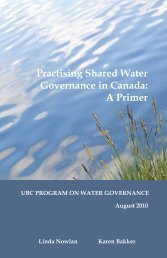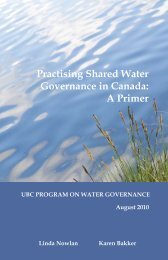Water Security Status Indicators - Program on Water Governance
Water Security Status Indicators - Program on Water Governance
Water Security Status Indicators - Program on Water Governance
Create successful ePaper yourself
Turn your PDF publications into a flip-book with our unique Google optimized e-Paper software.
WATER SECURITY GUIDANCE DOCUMENT<br />
PART 2 SECTION 4<br />
WATER SECURITY STATUS INDICATORS (WSSI)<br />
pate in objective and target setting to translate community goals into meaningful<br />
measures. As an example, the GRCA first identified a preliminary set of<br />
objectives to take to the community. This list was then discussed with various<br />
stakeholder groups and the broader public to ascertain whether these objectives<br />
were still current, or if modificati<strong>on</strong>s and/or additi<strong>on</strong>s were necessary.<br />
Once the parameters of water security have been identified, and likely ways<br />
to achieve these objectives identified (e.g., targets to reach, and a timescale to<br />
achieve this by), identify potential governance barriers (and if feasible future<br />
risks – see Part II, Secti<strong>on</strong> 2 and 3) that could inhibit achieving these goals. (See<br />
also step 6).<br />
STEP 4 –PREPARE INFORMATION NEEDED FOR ASSESSMENT<br />
a. Time frame: Define the time frame for the water security status assessment<br />
i.e., whether it will be <strong>on</strong>going (which is recommended) or whether<br />
it will be c<strong>on</strong>ducted as a <strong>on</strong>e-off.<br />
b. Key Issues: Identify key water-related issues for your area, and compile a<br />
list of the parameters that need to be m<strong>on</strong>itored and assessed. This could<br />
be further broken down to key issues in specific areas (e.g., a particular<br />
stretch of river, or aquifer). The issues should include human health and<br />
aquatic ecosystem health in terms of quality and quantity.<br />
c. Data Availability: Data form the foundati<strong>on</strong> up<strong>on</strong> which indicators are<br />
built, and c<strong>on</strong>sequently play a fundamental role in assessment. Data<br />
will most likely be dispersed across a number of organizati<strong>on</strong>s ranging<br />
from academics, c<strong>on</strong>sultants, industry, commercial, agriculture, NGOs,<br />
to municipal, provincial and federal agencies, each with varying degrees<br />
of quality, comprehensiveness and access. Identify organizati<strong>on</strong>s and/or<br />
departments that may have the data required for the assessment of water<br />
quality, quantity, aquatic ecosystem and human health. Find out whether<br />
staff are available and willing to provide advice and guidance; identify key<br />
c<strong>on</strong>tacts. Are there data for surface water and groundwater? Are the data<br />
accessible? Which parameters are m<strong>on</strong>itored and recorded? Over what<br />
time periods are data collected (<strong>on</strong>going or ad hoc)? It is important to ascertain<br />
data gaps during the initial assessment, as this understanding can<br />
also inform future planning. If using data from a variety of sources, identify<br />
the methods used to collect data. Are the reporting units and collecti<strong>on</strong><br />
methods the same or different between data sets? Once the parameters<br />
you want to measure have been identified, assess the datasets to see if<br />
these variables have been m<strong>on</strong>itored c<strong>on</strong>sistently. Assess whether any of<br />
the data sets are compatible enough to be amalgamated (ensuring that the<br />
reporting units are c<strong>on</strong>sistent).<br />
Suggesti<strong>on</strong>: If possible, arrange a meeting whereby representatives from<br />
all the agencies that collect data are brought together. Discussi<strong>on</strong>s should<br />
include why they collect data (what their drivers are); the relative comprehensiveness<br />
and gaps of their data (in terms of time periods or parameters<br />
measured); accessibility (data sharing); and the standards and methods<br />
used to collect and record data. This meeting could serve to establish<br />
str<strong>on</strong>ger pathways to facilitate data exchange. In additi<strong>on</strong>, this meeting<br />
8







